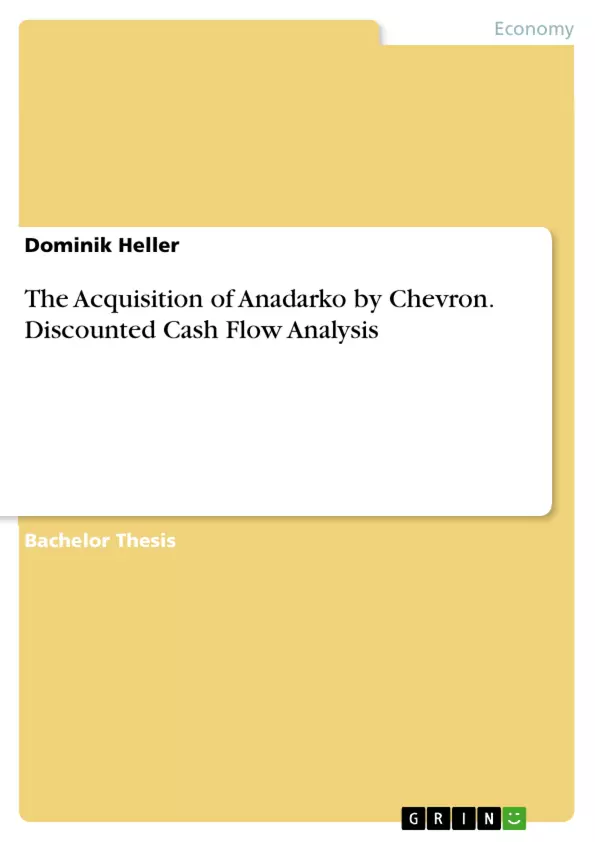In this thesis, I am going to value Anadarko using the Discounted Cash Flow (DCF) method and applying reasonable assumptions for post-merger synergy effects with Chevron. As validation for my forecast assumptions, which are based on predictions and trends from early 2019, I will include a summary of the overall Oil & Gas industry as well Anadarko’s and Chevron’s positioning alongside the different stages of the value chain. To estimate my cost of capital I will apply the WACC method instead of APV, using the cost of equity and cost of debt as input factors, together with a terminal growth rate instead of an approach with exit multiples. In order to determine how sensitive my results are concerning key input variables like the Weighted Average Cost of Capital (WACC) or the terminal growth rate I will also run a sensitivity analysis. Lastly, I will talk about the synergy estimates used in my calculations and bring them into context with my DCF calculations in order to determine if the transaction would create value for shareholders on both sides of the deal.
Although my calculations ultimately lead me to the result that the price originally offered by Chevron was fair, both in regards to Anadarko’s share price prior to the deal announcement as well as the intrinsic value determined by my DCF, the deal would not have benefited shareholders on both sides equally. While Anadarko’s shareholders would have gotten an immediate double-digit price increase, Chevron shareholders would have lost value with the acquisition, despite my calculations including significant synergies of roughly $1bn per year. The goal of my thesis, however, is not only to describe the assumptions, calculations and results of my DCF analysis, but to also bring them into a wider context.
On 12th April 2019 Chevron Corporation announced that they have agreed to acquire all outstanding shares of Anadarko Petroleum Corporation for a total consideration of $65 per share. This marked the first major transaction announcement for quite a while in the Oil & Gas (O&G) industry, which previously saw stock prices near their 10-year lows. Despite a good initial reaction from Anadarko’s shareholders, Chevron ended up missing out on the deal, with Occidental Petroleum Corporation, a close peer of Anadarko, buying the company for $76.67 per share.
Inhaltsverzeichnis (Table of Contents)
- 1.0 Introduction
- 2.0 Industry analysis
- 2.1 Company and Industry at a glance
- 2.2 Industry outlook
- 2.3 Firm Value Drivers
- 3.0 DCF Valuation
- 3.1 Forecasts
- 3.2 Choice of DCF methods
- 3.3 Leverage and Tax rate
- 3.4 Cost of Equity
- 3.5 Cost of Debt
- 3.6 Valuation results
- 4.0 Sensitivity analysis
- 5.0 Synergies
- 6.0 Value Creation
- 7.0 Conclusion
Zielsetzung und Themenschwerpunkte (Objectives and Key Themes)
This thesis aims to value Anadarko Petroleum Corporation using the Discounted Cash Flow (DCF) method, incorporating reasonable assumptions for post-merger synergy effects with Chevron. The analysis will incorporate insights from the Oil & Gas (O&G) industry, Anadarko and Chevron's positions within the industry, and their respective value chains. The WACC method will be used to estimate the cost of capital, along with a sensitivity analysis to assess the impact of key input variables. Lastly, the synergy estimates will be compared to the DCF calculations to determine if the proposed acquisition would have created value for both parties.
- Valuation of Anadarko Petroleum Corporation using DCF
- Analysis of the Oil & Gas industry and its outlook
- Determination of the cost of capital using WACC
- Assessment of synergy effects resulting from the potential merger
- Evaluation of the fairness of the proposed acquisition price
Zusammenfassung der Kapitel (Chapter Summaries)
- 1.0 Introduction: This chapter provides an overview of the acquisition of Anadarko by Chevron, outlining the initial bid, the final outcome, and the motivation behind the analysis.
- 2.0 Industry analysis: This chapter delves into the Oil & Gas industry, providing a brief overview of the company and the sector. It also analyzes the industry outlook and identifies the key value drivers for firms within this sector.
- 3.0 DCF Valuation: This chapter explores the DCF valuation method, outlining the assumptions used for forecasting and the selection of appropriate DCF methods. It also examines the determination of the cost of capital, including the cost of equity and cost of debt. Finally, the chapter presents the results of the DCF valuation.
- 4.0 Sensitivity analysis: This chapter analyzes the sensitivity of the DCF results to various input variables such as the Weighted Average Cost of Capital (WACC) and the terminal growth rate.
- 5.0 Synergies: This chapter discusses the potential synergies associated with the merger, providing an estimation of their value and outlining their significance for both Chevron and Anadarko.
- 6.0 Value Creation: This chapter examines the potential value creation resulting from the acquisition. It compares the estimated value with the original bid price, considering the perspective of both Chevron and Anadarko shareholders.
Schlüsselwörter (Keywords)
This thesis focuses on the valuation of Anadarko Petroleum Corporation using the Discounted Cash Flow (DCF) method. It analyzes the Oil & Gas industry, including its outlook and key value drivers. The analysis utilizes the WACC method for estimating the cost of capital, incorporating cost of equity and cost of debt. The thesis further investigates the potential synergies of the proposed merger and evaluates the acquisition price's fairness, considering the value creation perspective for both companies.
- Arbeit zitieren
- Dominik Heller (Autor:in), 2020, The Acquisition of Anadarko by Chevron. Discounted Cash Flow Analysis, München, GRIN Verlag, https://www.grin.com/document/1011639



